
Although your nonprofit has a strong guiding mission motivated by a worthy cause, it’ll be difficult to see your goals through if you don’t have a roadmap to carry out that mission effectively. A nonprofit strategic plan gives your organization the foundation it needs to weather any storm and stay on track to completing your objectives.
However, organizations may deprioritize strategic planning in favor of what they consider more mission-critical activities. In fact, 48% of leaders devote less than one day per month to discussing their strategy. As a result, the same percentage of organizations don’t meet half of their strategic goals, let alone all of them.
To help your nonprofit reach its goals and provide a framework for long-term success, we’ll explore everything you need to know about nonprofit strategic planning, including:
- 3 Nonprofit Strategic Planning FAQs
- 3 Steps for Creating a Nonprofit Strategic Plan
- The Essential Nonprofit Strategic Plan Template
- Top 10 Examples of Nonprofit Strategic Plans
- 6 Tips for Maintaining Your Nonprofit Strategic Plan
- How a Nonprofit Consultant Can Support Strategic Planning
It’s easier to advance your mission and power more charitable endeavors in your community when you’re backed by a comprehensive nonprofit strategic plan. Let’s begin!
3 Nonprofit Strategic Planning FAQs
Before we jump into how to create your strategic plan, you’ll need to have the basics down. Let’s break down what a nonprofit strategic plan is and how it can benefit your organization.
What is a nonprofit strategic plan?
A nonprofit strategic plan is a bold plan of action that aligns an organization’s goals with its values to provide a dynamic performance map for future endeavors.
While you can’t anticipate all the slowdowns or obstacles that might arise for your organization, a thorough plan allows your nonprofit to prepare for any challenges that may come your way with a mindset driven by an overarching blueprint.
Why should my organization create a nonprofit strategic plan?
Without a strategic plan, it’s impossible to know where you’re going or how you will get there. For example, let’s say you want to engage more donors to power community initiatives. How will you measure your success? What campaigns or stewardship activities will you lead? Without clear answers to these questions, you won’t be prepared to confidently tackle your objectives.
A nonprofit strategic plan helps simplify decision-making whenever your organization reaches a crossroads or an unexpected situation. It provides focus to the various teams within your nonprofit so that everyone, from your board to staff leaders, is on the same page.
What are the benefits of strategic planning for nonprofits?
From simplifying decision-making to helping your organization achieve its goals, there are a variety of benefits to nonprofit strategic planning, including:
- Better time management. When you develop a nonprofit strategic plan, you’ll learn how to effectively prioritize your daily activities and save your team time.
- Enhanced decision-making. Your nonprofit strategic plan will help you say no to projects that don’t fit your priorities. Sticking to the plan simplifies the decision-making process.
- Improved staff and board management. A well-developed strategic plan clearly defines responsibilities to ensure staff and board members understand their roles. That way, you can spend less time managing your team and more time executing your mission.
- Better understanding of your guiding principles. Regularly reviewing your organization’s principles can help rally your board and staff to achieve your organization’s key priorities.
- Strengthened mission statement. Use the nonprofit strategic planning process as an opportunity to review your mission and make sure it’s still accurate and relevant. Mission statements shouldn’t change radically from year to year, but they do often languish from lack of attention. Use this time to check in with your team and make sure your mission captures the essence of your work.
- Opportunity to assess results. When you set strategic goals, you set your organization up for success. Track key performance indicators (KPIs) that align with your goals to foster accountability, demonstrate your impact and improve your approach.
By investing the necessary time and energy into nonprofit strategic planning, you can positively influence your organization for years to come.
What are the different types of strategic plans for nonprofits?
Your organization may desire a strategic plan to get through a specific initiative or unexpected event, or you may just want guidelines for the years ahead. There are different types of strategic plans based on your nonprofit’s primary objective, including:
- Standard strategic plan: This is a typical roadmap to achieve your organization’s long-term goals. It’s best suited for nonprofits with stable internal and external conditions. If your nonprofit has good standing in the community, isn’t experiencing any political or economic threats and has consistent donor support, you can benefit from this traditional strategic approach.
- Issue-based strategic plan: Unlike a standard strategic plan, an issue-based strategic plan is favorable for nonprofits with a specific internal problem. For instance, consistently falling short of your online fundraising goals or experiencing increased staff turnover would constitute a need for issue-based strategic planning. Your goals for this type of plan will be more specific so you can correct the given issue.
- Organic strategic plan: An organic strategic plan for nonprofits is similar to an issue-based strategic plan but is ideal for organizations facing an external threat. For example, a new government policy that affects your nonprofit’s work might prompt you to create this type of plan. An organic strategic plan allows you to consider how this external threat impacts your nonprofit and how you can proactively adjust your strategy to meet your goals.
- Real-time strategic plan: A real-time strategic plan is necessary for nonprofits experiencing an unexpected event, like a natural disaster. For example, if you run an animal rescue organization, and a hurricane damages several shelters, you’ll need this plan to act fast. Rather than making long-term goals for the future, this plan involves setting short-term goals to quickly solve the problem at hand.
- Alignment strategic plan: An alignment nonprofit strategic plan seeks to improve collaboration between different nonprofit teams. This type of strategic planning involves brainstorming ways your team members can better work together and laying out a framework for more seamless communication, such as establishing monthly check-in meetings between different teams.
Consider the different obstacles and opportunities your nonprofit currently faces to help you decide which type of nonprofit strategic plan makes the most sense for you. Keep in mind that while the situational factors that raise the need for these different types of plans may differ, the core planning process is the same. By embarking on the strategic planning process, you’ll be equipped to lay out a clear framework for turning your goals into reality.
3 Steps for Creating a Nonprofit Strategic Plan
Aly Sterling Philanthropy recommends adopting an individualized nonprofit strategic planning model that focuses on strengthening your organization’s financial health, capacity, effectiveness and relevance within the community. This process involves a partnership with an experienced nonprofit consultant, who brings robust planning tools and resources.
The essential steps of this strategic planning approach include:

1. Assess
The nonprofit strategic planning begins with a pre-planning process, which includes a dive deep into your organization’s history, infrastructure, core programs and vision for the future.
Another element of the pre-planning process is surveying stakeholders to gather their insights and opinions. Depending on your nonprofit’s situation, your stakeholders may include:
- Current and past board members
- Current and past annual, major and planned giving donors
- Influential community members, such as political leaders, foundations, trust officers and church leaders
- Volunteers and staff
- Certain recipients of your services, such as patients, alumni or consumers
When conducting these interviews, choose participants carefully. Seek various perspectives, including those from individuals who’ve expressed discontent with certain aspects of your organization. These viewpoints provide the constructive criticism needed to help your organization grow and become more effective.
Donor or volunteer surveys are also a great way to continue your supporter stewardship efforts. Supporters are typically flattered to be asked to participate and offer their points of view.
2. Align
The next step of nonprofit strategic planning is engaging your board and staff members in a dynamic strategic planning retreat. This encourages organizational leaders to consolidate and discuss their thoughts in a dedicated, action-oriented forum.
Within this half-day retreat, leaders will establish priorities and start to visualize what success looks like with the help of the consultant. During this time, the consultant will facilitate conversation and activities that build consensus and gather suggestions for short- and long-term opportunities and hurdles.
3. Act
In the final strategic planning step, your nonprofit’s consultant will summarize their findings and offer a recommended action plan to your organization’s leadership. The consultant will use feedback from the interviews, surveys and planning retreat to help your team set key priorities and build out the key objectives, performance indicators and a timeline for completion. This encourages accountability throughout the implementation process.
In the Aly Sterling Philanthropy nonprofit strategic planning model, a consultant leads your team through each step of the process. This specialist facilitates everything, from stakeholder surveys and the planning retreat to the final strategic plan document.
By the end of the planning process, your organization will have a dynamic action plan.
The Essential Nonprofit Strategic Plan Template
Your organization’s strategic plan will be based on several guiding pillars. These pillars are the elements within your organization that require the most attention. In this section, we’ll present a template for what your organization’s plan might look like and explain each element.
Let’s start by walking through the five pillars a nonprofit strategic plan should focus on:
- Mission clarity: Why are you in operation? What does your nonprofit do to make a difference in the community?
- Marketing and PR: How do you communicate your mission to a wider audience?
- Financial sustainability: How do you sustain your operations?
- Community engagement: How do you raise awareness of your mission in the community and earn support?
- Infrastructure and process: Is your organization’s infrastructure aligned with your strategic goals?
Here is an example plan for the fictional XYZ Foundation. The first page of this nonprofit strategic plan summarizes each of these pillars, including the specific goal and action steps associated with each:
Use this blank version to add your nonprofit’s pillars and action steps:

Next, break down each pillar into its own chart to pinpoint specific actions and tasks associated with every priority:
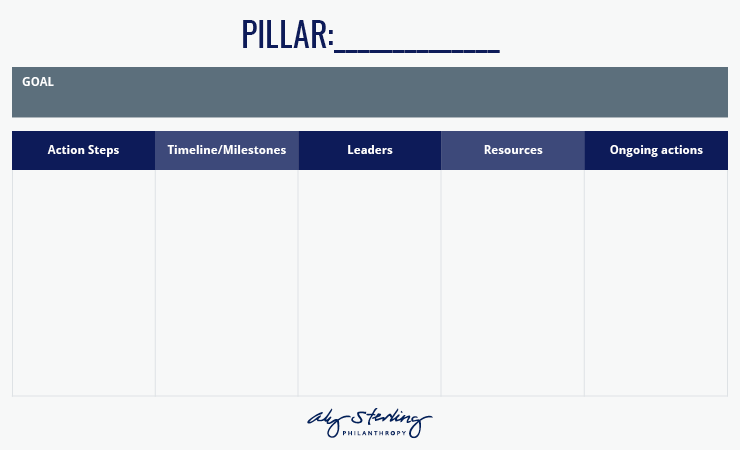
For each priority, determine the associated action steps, timeline/milestones, leaders, necessary resources and future/ongoing actions:
- Action steps: What tasks, projects or events are necessary to complete the priority? List out each required step that will allow your team to complete the goal.
- Timeline/milestones: When should you complete each task? Having a set timeline for each step fosters accountability.
- Leaders: Which team member(s) will take responsibility for each task? Ensure each person understands their role and the associated timeline for completing their tasks.
- Necessary resources: What resources will you need to be able to complete each task? These might include people, databases or input from board members or staff members.
- Future/ongoing actions: How will you ensure that team members will continue to handle any ongoing actions instead of letting them fizzle out? Determine the timeline and team member responsibilities for maintaining each priority.
These documents will provide a tangible resource your team can turn to for guidance as they carry out your nonprofit strategic plan. Fill out these templates using your organization’s top priorities and tasks associated with each step.
Top 10 Examples of Nonprofit Strategic Plans
While your nonprofit strategic plan should be unique to your organization, it’s helpful to draw inspiration from other organizations to guide your approach. See what’s possible for your nonprofit by exploring this list of top nonprofit strategic plans.
1. Boys and Girls Club of America
The Boys and Girls Club of America is dedicated to creating brighter futures for young people across the country. As a national organization with an ambitious mission, it was essential for the Boys and Girls Club of America to craft a comprehensive strategic plan that unites their Club partners and families around their vision for the future.
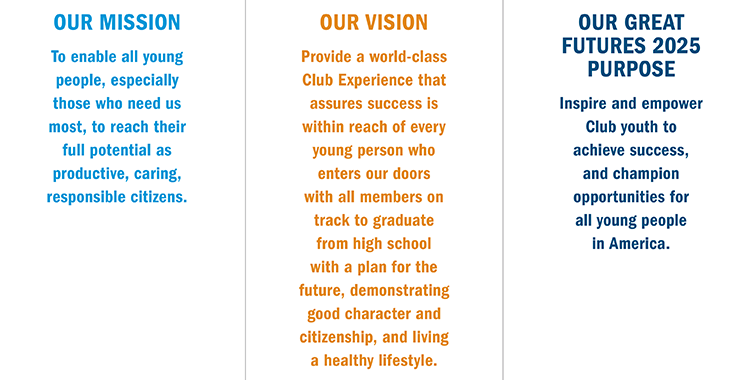
In their nonprofit strategic plan titled “Great Futures 2025,” the Boys and Girls Club outlines four strategic priorities that will help them cultivate young leaders:
- Increase program quality
- Strengthen organizations
- Advocate for youth development
- Reach more youth
To reach these goals, this nonprofit has outlined specific initiatives they’ll lead, such as improving program effectiveness through establishing quality standards, increasing government funding for youth development and building strong partnerships with schools. This level of specificity gives the Boys and Girls Club a clear framework to achieve its goals over the next few years.
2. Legal Aid Foundation of Los Angeles
The Legal Aid Foundation of Los Angeles seeks equal justice for impoverished individuals in the greater Los Angeles area. To bring this mission to fruition, the Legal Aid Foundation created a dynamic strategic framework that addresses the specific actions they’ll take over the following five years.
Their plan lays out the following seven strategic priorities:

- Legal services
- Staff development
- Technology
- Governance
- Community
- Pro bono
- Financial & fund development
Not only does this organization detail what their priorities are, but they also identify the staff leads, the specific goals and the metrics that will be used to measure success for each priority. Plus, the Legal Aid Foundation explains how each strategic priority connects back to its cause and founding principles, grounding its plan in its mission.
3. Ronald McDonald House Charities of Northwest Ohio
The Ronald McDonald House Charities of Northwest Ohio aims to enrich the lives of sick children and their families by providing housing, resources, educational programs and more. This charity created a nonprofit strategic plan for 2022-2025 to become a leader in access to healthcare for children.

Their plan is organized around strategic initiatives like building capacity to support the programmatic needs of the community and identifying and implementing opportunities to enhance quality healthcare access. With these guiding priorities in place, the Ronald McDonald House Charities of Northwest Ohio can effectively put their dreams into action.
4. Goodwill Industries of Northwest Ohio
Goodwill Industries of Northwest Ohio is devoted to eliminating barriers to work and providing opportunities for people to reach their full potential. Guided by their philosophy of the “power of work,” Goodwill needed a nonprofit strategic plan to help community members live independently, earn a fair living wage and meet their personal goals.
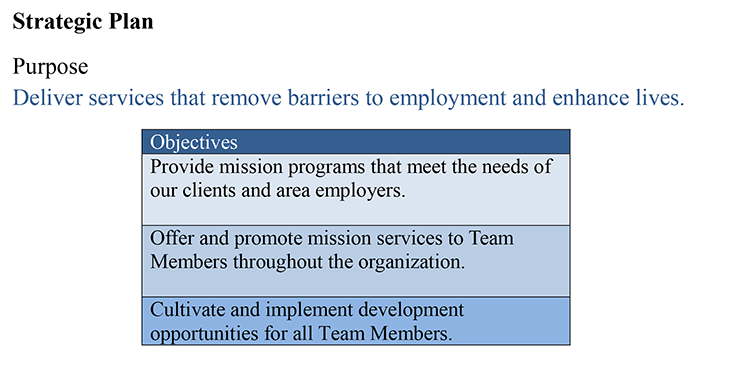
Their 2022-2024 strategic plan begins by outlining their vision and values, including integrity, passion and respect. Next, the plan identifies specific objectives to transform lives in their community, organized into categories like financial sustainability and community. This guide is a great reference point for their staff and ensures everyone is on the same page.
5. Metroparks Toledo
Metroparks Toledo is a park district committed to conserving the region’s resources through the management of natural parks and open spaces. As explained in the introduction of their nonprofit strategic plan, Metroparks hopes to not only improve outdoor spaces for the enjoyment of the public but also cultivate high performance and satisfaction among park employees.

In their strategic plan, Metroparks kicks off with an overview of who they are, their mission and their vision for the future. Then, they break down the following strategic priorities:
- Maintenance of core services
- Organizational health
- Diversity, equity and inclusion
- Becoming the leader in natural resource conservation
- Engagement in our story
- Strategic community partnerships
- Sustainability of funding
Following the Aly Sterling Philanthropy strategic planning model, Metroparks outlines a plan of action for each of these priorities, including key objectives and key performance indicators to measure their progress. This helps Metroparks’ community members and employees understand the actions this organization will take to advance their mission.
6. Alzheimer’s Association
The Alzheimer’s Association seeks to end Alzheimer’s and other forms of dementia by conducting global research, driving risk reduction and early detection and improving access to quality care. This organization released a 2023-2025 strategic plan to accelerate its mission and change the trajectory of Alzheimer’s for millions of people.
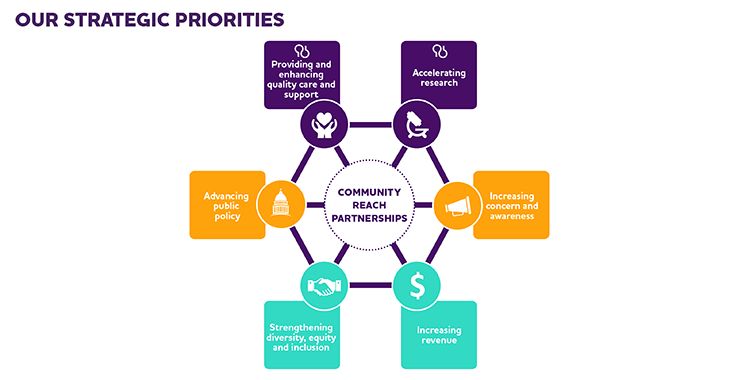
The Alzheimer’s Association builds a strong case for support in their strategic plan by identifying relevant statistics, like the rising costs associated with Alzheimer’s in the nation, which is projected to be more than $1.1 trillion in 2050. They then cover their strategic priorities, including advancing public policy, increasing revenue and boosting awareness.
To establish a clear framework for their projected progress, the Alzheimer’s Association outlines strategic, measurable objectives. For instance, they explain that they’ll accelerate research by providing more funding opportunities, aiming to invest $110 million by the end of 2025. This specificity provides their entire team with the clarity necessary to complete their responsibilities and contribute to the Alzheimer’s Association’s success.
7. Bryan Area Foundation
The Bryan Area Foundation is a community foundation that strives to improve the lives of individuals living in Williams County, Ohio. One of their central projects is providing millions of dollars to worthy community projects and scholarships. To continue this charitable giving (along with other initiatives), the Bryan Area Foundation needed a nonprofit strategic plan that outlined how to make this possible.

In their 2021 to 2023 strategic plan, the Bryan Center Foundation identified new projects to complete, including a revitalization of downtown Bryan to grow the number and quality of businesses. Since launching this plan, the Bryan Center Foundation has created a Community Impact Project and Forgivable Loan Program, supporting their commitment to “Building for the future.”
8. DeKalb County Community Foundation
The DeKalb County Community Foundation’s mission is to benefit organizations and communities throughout DeKalb County, Illinois. In its nonprofit strategic plan for 2022-2024, this foundation outlines how it intends to create change by addressing the following four key areas: Endowments and Donor Services, Stewardship, Grantmaking and Community Initiatives.

DeKalb County Community Foundation’s goals and objectives are precise, with measurable objectives like realizing a minimum 3% financial donations increase in annual contributions to Community Impact Funds. Specific, measurable goals give this foundation the direction it needs to maximize its success and foster accountability across its team.
9. World Wildlife Fund of Colombia
The World Wildlife Fund (WWF) of Colombia aims to set Colombia on a path to sustainable, low carbon and resilient development. WWF created a nonprofit strategic plan for 2020-2025 to address its ambitious goal of making the country a better place for people and wildlife.
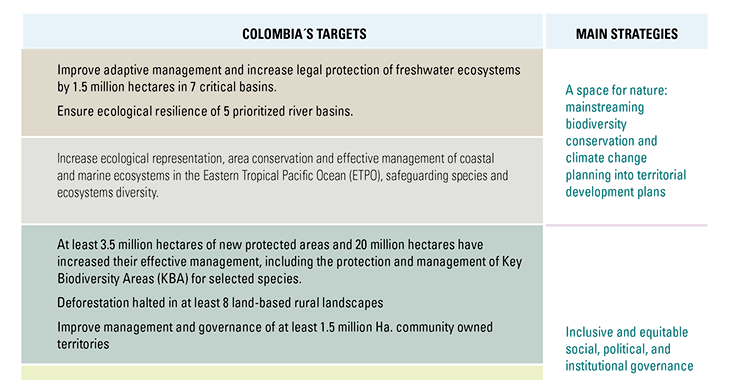
The organization’s strategic plan is centered around three main priorities:
- Mainstreaming biodiversity, conservation and climate change planning into territorial development plans
- Promoting inclusive and equitable social, political and institutional governance
- Advocating for responsible consumption, markets and financial institutions
WWF not only addresses Colombia’s strategies and goals in its strategic plan document but also global targets to improve people’s and animals’ lives worldwide. This helps to connect WWF Colombia to the core principles and mission that define WWF as a whole.
10. Big Brothers Big Sisters of Central Mass & Metrowest
Big Brothers Big Sisters of Central Mass & Metrowest (BBBSCM) was established to create professionally supported mentoring relationships and build brighter futures for today’s youth. In their nonprofit strategic plan for 2020-2023, BBBSCM detailed its mission, vision, values and beliefs, making it a great resource for supporters getting to know their organization and for staff and volunteers to reference in their work.

Then, this organization established its top four priorities and associated objectives, such as increasing sustainable funding by identifying new major donor prospects, with the goal of adding three to five major donors per year. BBBSCM also identified its strengths, challenges, threats and opportunities and tailored its strategic plan to these elements.
As a result, BBBSCM demonstrates in its strategic plan document that its team is committed to seeing its mission through and will take the necessary steps to create its vision for the future.
Here are some of our top tips for keeping your strategic plan alive:
- Fill out the above templates using information from your retreat. Formalize your plans in a document that is shared across your organization. As you fill out the template, take a “less is more” approach and only include essential information. Also, make sure you’re setting goals that are specific, measurable, attainable, relevant and time-bound (SMART) so your objectives are highly actionable and easy to follow.
- Work as a group. Create a task force to work collaboratively on your nonprofit strategic plan. Keep the group large enough to be helpful but not so large as to be a roadblock.
- Present your plan to key stakeholders. Host regular check-in meetings as a team to measure progress and maintain accountability. Gather stakeholder feedback to constantly improve your strategic plan.
- Keep your plan front and center by posting it in a visible location. Print and post your strategic plan in a communal space, such as your office or conference room, and ensure it’s also digitally accessible. That way, your key objectives will stay top of mind for your staff members.
- Explain your plan in a public formal presentation. When you make your plans known to a wider audience, it increases the expectation that you will see them through. It also engages your community and stakeholders in your organization’s plans.
- Celebrate successes. Plan celebrations for when you reach key milestones throughout your plan to recognize successes and keep staff and stakeholders informed of your progress. Plus, having a celebration to look forward to can motivate your team to complete its goals!
With these tips, you can maintain the initial excitement and momentum built during your strategic planning process. This will ensure your plan is doing what it was meant to—furthering your organization’s mission effectively.
How a Nonprofit Consultant Can Support Strategic Planning
The right nonprofit consultant will walk you through every step of the nonprofit strategic planning process. By tapping into their years of expertise, they’ll help you craft a dynamic framework to improve your organization’s financial health, effectiveness, capacity and relevance within your community.
Your consultant will support your strategic planning by:
- Collecting stakeholder insights in the beginning stages of the planning process
- Leading your team through a productive retreat
- Compiling findings into a plan of action and final strategic plan document
In addition to these core services, your consultant can also help you:
- Create a fundraising strategy that will lead to stronger supporter relationships and a sustainable donation pipeline
- Examine your existing tech stack and suggest solutions to augment your toolkit
- Identify donor stewardship strategies that will encourage donors to give more frequently and in larger amounts
- Strengthen your internal team, from your staff to your board members, so everyone is working to fulfill your mission
Do your research to find the right consulting firm that will thoughtfully and objectively consider your nonprofit’s current state and work with you to create a pathway to success. When you partner with the expert consultants at Aly Sterling Philanthropy, you can get an unbiased look at your organization and receive realistic guidance to construct your strategic plan.
Wrapping Up
When it comes to making your mission a reality and following through on your promises, don’t just wing it! A nonprofit strategic plan gives you the necessary framework to confidently tackle your goals, unify your team and leave a lasting impact on your community.
While taking an in-house approach to strategic planning is possible, it can be challenging to build a cohesive, objective plan from the inside. Contact us for help creating a comprehensive strategic plan that empowers you to achieve your goals.
For more information on nonprofit strategic planning, check out the following resources:
- 10 Easy Steps to Supercharge Your Fundraising Strategy. In addition to an overarching strategic plan, your organization can benefit from a blueprint made specifically to guide your fundraising. Use this guide to craft a plan that optimizes your nonprofit’s fundraising efforts.
- How to Create a Successful Fundraising Plan + Template. Having a formalized roadmap to guide your fundraising is critical to keep your organization on task. Use this template to construct your fundraising plan.
- Top 24 Nonprofit Consultants and How to Choose One: A Guide. Nonprofits often need guidance in a wide range of different areas. This list of top consultants includes experts who specialize in various topics.